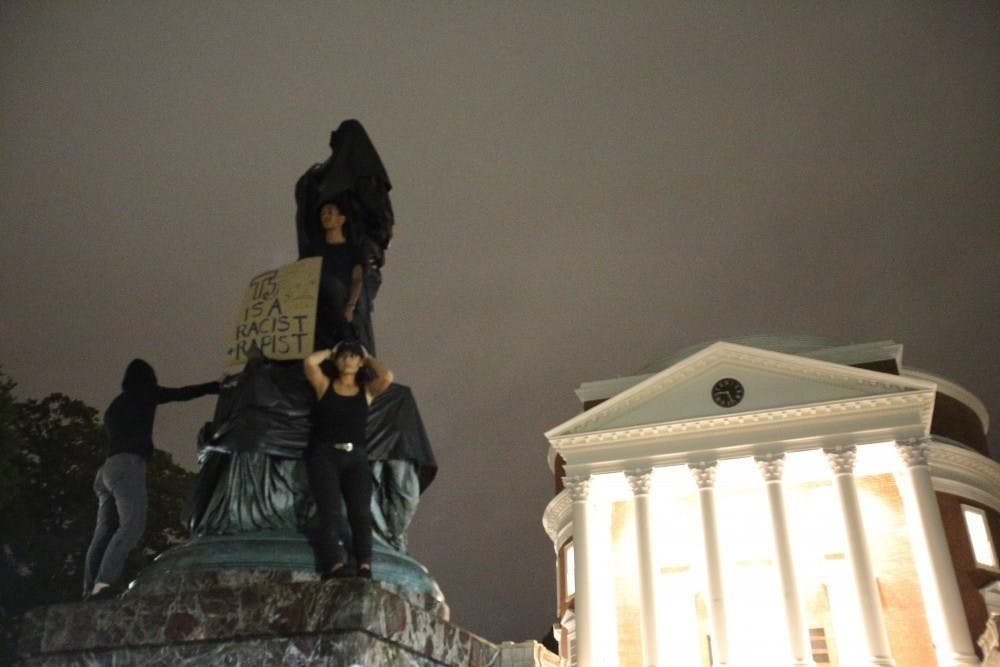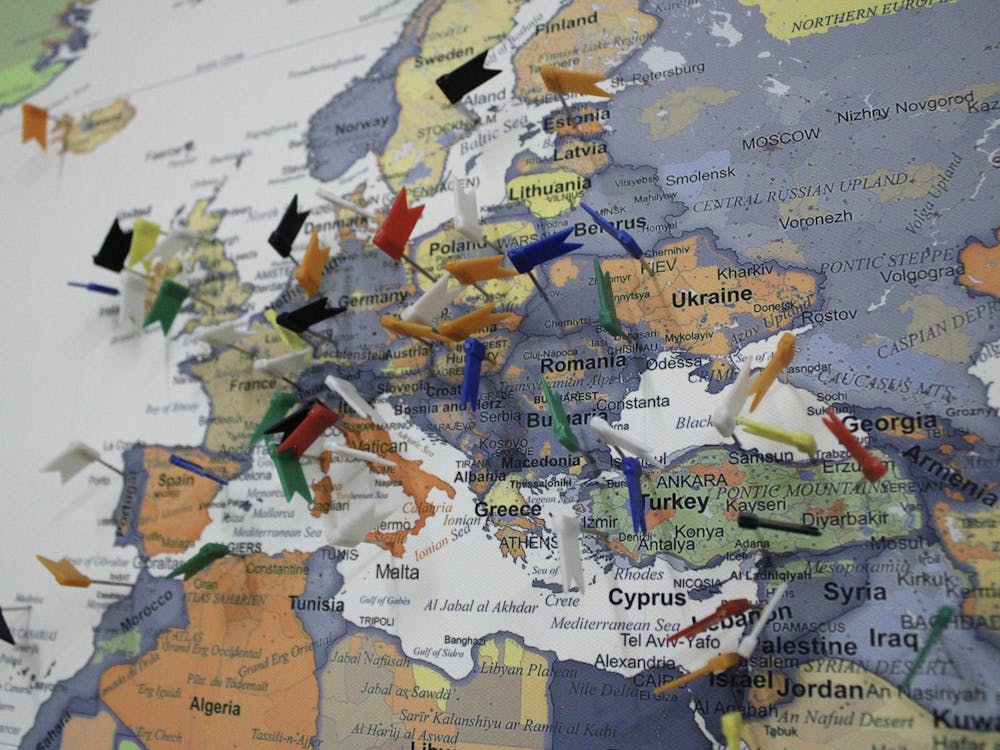At the unveiling of the statue of Thomas Jefferson in front of the Rotunda, former University President Edwin Alderman praised sculptor Moses Jacob Ezekiel for being a “soldier of Lee” and heralded Jefferson for his “self-sacrifice.” Left unmentioned by President Alderman was slavery. Indeed, of the four men to speak at the statue’s 1910 unveiling, only one — Board of Visitors member Daniel Harmon — made even a passing reference to slavery, calling it “the thraldom of those ancient laws.”
More than a century later, protesters shrouded the bronze Jefferson in black fabric — a response to the Unite the Right rally of Aug. 11-12, 2017. At the time, the Editorial Board of The Cavalier Daily’s 128th term reflexively defended Jefferson as “deserving of commemoration,” distinguishing him from Confederate General Robert E. Lee. Yet the most prominent Jefferson statues on Grounds belong to the same historical project as the Lee statue on Market Street — glorifying slaveholders in the Jim Crow South.
The unveiling of Ezekiel’s Jefferson statue in front of the Rotunda provides the most salient document of the statues’ historical project, but other evidence abounds. Although Ezekiel eventually characterized slavery as “evil,” he grew up in a slaveholding household that dressed enslaved people for auctions. During the war, he served as a Confederate private, later feeling “humiliation” as he witnessed “set-free Negroes.” Long after the war, Ezekiel called the Confederacy a “lost but righteous cause,” kept a Confederate flag over his bed and considered a Lee monument “the one work [he] would love to do above anything else in the world.”
As a sculptor, Ezekiel repeatedly memorialized the Confederacy, making Confederate memorials in Ohio, Kentucky and Virginia, as well as statues of Confederate General Stonewall Jackson, “Virginia Mourning Her Dead” and Senator John Warwick Daniel, a Confederate major and proponent of the Lost Cause. Ezekiel’s Jefferson is not an exception to his devotion to the Lost Cause, but part of it. Ezekiel lamented that during Reconstruction, “an ignorant Negro” sat in a legislature “where Thomas Jefferson had once sat.” To Ezekiel, Jefferson embodied the past the Lost Cause idealized.
The University’s other Jefferson statue from the Jim Crow era is by Austrian-American sculptor Karl Bitter. At the 1915 unveiling of that statue, President Alderman described it as “the face and form of Thomas Jefferson as in his old age” — again presenting an unadulterated portrait of the University’s founder. Whereas Ezekiel’s statue shows Jefferson at the age of writing the Declaration of Independence, Bitter’s statue shows Jefferson at the age of founding the University. The inscription at the base of Bitter’s statue is a quote from Jefferson about “fostering an establishment for the instruction of those who come after us.” Yet Jefferson’s vision for the University excluded most of its current students. By eliding a racist past, Bitter’s statue rewrites history of the University — ignoring the ancestral land claims of the Monacan Nation, the labor of enslaved people, the University’s violence toward Black bodies and Jefferson’s architecture of segregation.
The oldest Jefferson statue on Grounds is by Alexander Galt, who later served as a Confederate army officer and made a bust of Confederate President Jefferson Davis. Installed in 1860, the Jefferson statue exemplifies the burgeoning sectionalism of the antebellum South. When it commissioned the statue in 1854, the Virginia General Assembly struck out the name of a northern sculptor and replaced it with Galt, a native Virginian. To understand Jefferson, Galt consulted with Thomas Jefferson Randolph, the source of the false claim that Jefferson’s nephew fathered Sally Hemings’s children. By prioritizing white perspectives, Galt’s statue makes a judgment about which histories matter.
Although the most recent Jefferson statues on Grounds are from 1978 and 2007, there is still reason to remove them. Last year, in the book “Educated in Tyranny: Slavery at Thomas Jefferson’s University,” co-editor Maurie McInnis criticized the 2007 statue — by Eugene Daub and Robert Fermin — for depicting a solitary Jefferson surveying land for the University. In reality, Jefferson was accompanied by 10 enslaved “hands,” along with his overseer and an Irish joiner. Like Bitter’s statue, Daub and Fermin’s statue — located at the Darden School of Business — glorifies a slaveholder while ignoring the enslaved. Not even the plaque below the statue mentions slavery.
The other recent statue is by Lloyd Lillie, who died in February. The second of three castings, Lillie’s statue — located in Purcell Garden at the School of Law — depicts Jefferson alone in contrapposto. For the 1978 dedication of that statue, ceremony overseer Dean B. F. D. Runk consulted President Alderman’s 1910 remarks on Ezekiel’s Jefferson, and the plaque formerly below the statue quoted Jefferson on education without mentioning the prejudice of his educational vision. Even after integration and coeducation, the University still clung to the negationist history of its founder.
Maybe the University can acknowledge Jefferson on Grounds without glorifying him, but statues made to glorify Jefferson perpetuate a false history. Jefferson’s association with this University is a cause for shame, not statues. Being born in the South does not excuse Jefferson. Inheriting enslaved people does not excuse Jefferson. The founder of this University chose a life of opulence over a life of morality — bluntly acknowledging that enslaved people “labor” for his “happiness” and fathering at least six children with a woman he enslaved. To follow the truth, the University must remove Jefferson from his pedestal.
Adam Grim is an Opinion Columnist for The Cavalier Daily. He can be reached at opinion@cavalierdaily.com.
The opinions expressed in this column are not necessarily those of The Cavalier Daily. Columns represent the views of the authors alone.







